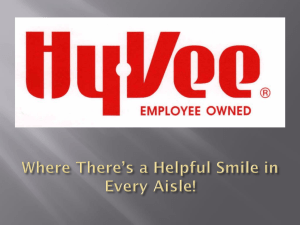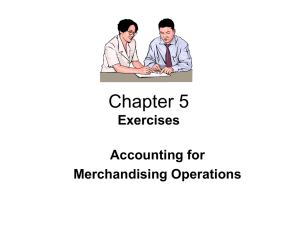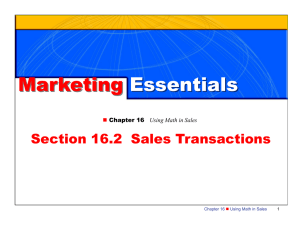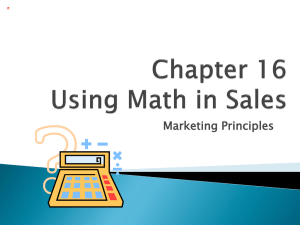Chapter 1
advertisement
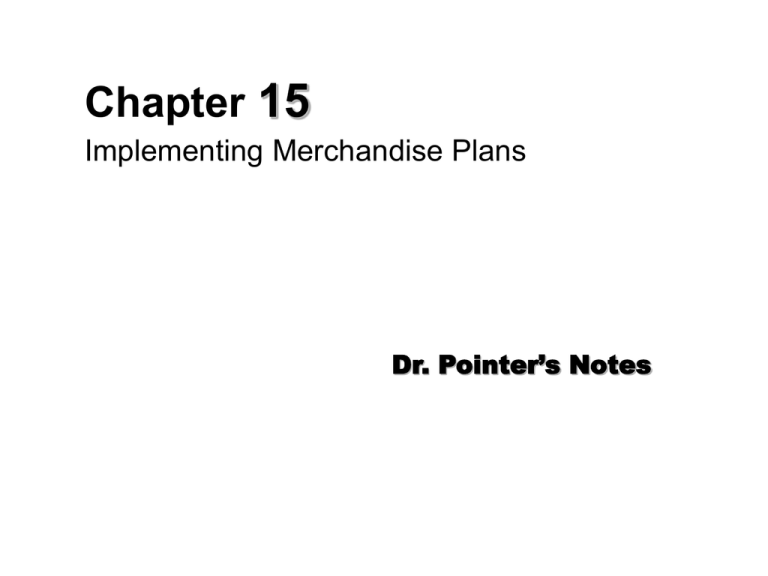
Chapter 15 Implementing Merchandise Plans Dr. Pointer’s Notes Chapter Objectives To describe the steps in the implementation of merchandise plans: gathering information, selecting and interacting with merchandise sources, evaluation, negotiation, concluding purchases, receiving and stocking merchandise, reordering, and re-evaluation To examine the prominent roles of logistics and inventory management in the implementation of merchandise plans 15-2 Figure 15.1 The Process for Implementing Merchandise Plans Gathering Information Re-Evaluation 15-3 Interacting with merchandise source Reordering Evaluation Receiving and stocking merchandise Negotiation Concluding Purchases Gathering Information Need to gather additional information regarding the market place Focus is on what target market wants Loyalty programs provide lots of data on consumer purchases Suppliers (manufacturers and wholesalers) are good sources of information Want Book – listing of requested products by customers 15-4 Gathering information 2 Other sources of information ● government supplier information – Different apparel marts ●Dallas market center ●Trade show ●Web Need to gather sufficient information to make good decisions 15-5 Selecting and Interacting with Merchandise Sources Company owned- large retailers own or manufacture merchandise Outside, regularly used supplier – independent supplier who is used often Outside, new supplier- independent supplier who is new and must be qualified because they are unfamiliar with merchandise quality and reliability Chargebacks are growing problems( retailers make deductions on bills for late shipments, damaged or expired goods and etc.) 15-6 Evaluating Merchandise Need to have procedures to evaluate merchandise as it comes in ●Inspection ●sampling ●Description buying is used with standardize, nonbreakable, and nonperishable merchandise 15-7 Negotiating the Purchase Retailer must know how to negotiate purchases and its terms New or special orders results in negotiated contracts Regular or reorder involves a uniform contract Off Price Retailer use: Opportunistic buying - negotiating very low prices when vendor’s sales are low or they have overstocks Delivery dates, quantity ordered must be clear Purchase price and form of payment and discounts Slotting Allowances- payments for providing shelf space for merchandise (retailers are requiring more of these from manufacturers) 15-8 Concluding Purchases The retailer takes title immediately on purchase The retailer assumes ownership after titles are loaded onto the mode of transportation The retailer takes title when a shipment is received The retailer does not take title until the end of a billing cycle, when the supplier is paid The retailer accepts merchandise on consignment and does not own the items. The supplier is paid after merchandise is sold Consignment purchases- vendors owns merchandise until retailers sells it Memorandum Purchases-retailer takes title but does not pay until merchandise is sold 15-9 Receiving and Stocking Merchandise This involves receiving and storing the merchandise, paying invoices, price and inventory markings, setting up displays, figuring n floor assortments, completing transactions, arranging delivery, processing returns and damage goods, monitoring pilferage and controlling merchandise 15-10 Reordering Merchandise Four critical factors: * Order and delivery time * Inventory turnover * Financial outlays * Inventory versus ordering costs* Large inventory may be good because you can meet customers’ needs, get bigger discounts and other cost savings but it could also mean higher risks and costs * Small inventory reduces risks but require more frequent reordering and higher ordering costs 15-11 Re-Evaluating on A Regular Basis Merchandise plan must be reevaluate often Overall procedures and handling of merchandise should be monitored Conclusions become a part of information gathering stage for future efforts 15-12 Logistics Logistics is the total process of planning, implementing, and coordinating the physical movement of merchandise from manufacturer (wholesaler) to retailer to customer in the most timely, effective, and cost-efficient manner possible 15-13 Logistics Performance Goals Relate costs incurred to specific logistics activities Place and receive orders as easily, accurately, and satisfactorily as possible Minimize the time between ordering and receiving merchandise Coordinate shipments from various suppliers Have enough merchandise on hand to satisfy customer demand, without having so much inventory that heavy markdowns will be necessary 15-14 Performance Goals_2 Place merchandise on the sales floor efficiently Process customer orders efficiently and in a manner satisfactory to customers Work collaboratively and communicate regularly with other supply chain members Handle returns effectively and minimize damaged products Monitor logistics’ performance Have backup plans in case of breakdowns in the system 15-15 Supply Chain Management The supply chain is the logistics aspect of a value delivery chain and comprises all of the parties involved in getting product from manuf to consumer * Parties involved • Manufacturers • Wholesalers • Third-party specialists • Retailer 15-16 Supply Chain Management Retailers and suppliers seek closer relationships as a way to improve profits Collaborative planning,forecasting and replenishment (CPFR) is a holistic approach to supply chain management among the network of trading partners Third party logistics (outsourcing) is increasingly used Web is used to facilitate communications between supplier and retailer 15-17 Order Processing and Fulfillment Quick Response Inventory Planning (QR) is a system to reduces amount of inventory it holds by reordering more frequently and in lower quantities. Floor-ready merchandise- merchandise comes preticketed and ready to be placed immediately on the floor (retailer saves time and costs) Electronic data interchanges (EDI) facilitates QR via a computer to computer relationship between vendor and retailer 15-18 Order Processing and Fulfillment_2 Efficient Consumer Response (ECR) Planning permits supermarkets to incorporate aspects of QR inventory planning EDI and logistics planning. This addresses multiple aspects including ordering, new product intro, item assortment and promotions. Advance Ship Notices – alerts retailers and allows them to plan better 15-19 Transportation and Warehousing How often will merchandise be shipped to the retailer? How will small order quantities be handled? What shipper will be used? What transportation form will be used? Are multiple forms required? What are the special considerations for perishables and expensive merchandise? How often will special shipping arrangements be necessary? How are shipping terms negotiated with suppliers? What delivery options will be available for the retailer’s customers? 15-20 Customer Transactions and Customer Service Need to be able to facilitate customer purchases in a way which makes customers happy. Can be as easy as customer picking up merchandise from a display and taking to cashier Can be as complex as completing a web purchase that must be shipped from multiple suppliers (Mail order retailers do this often – to be shipped from supplier) 15-21 Inventory Management Inventory management is utilized to acquire and maintain proper merchandise assortment while ordering, shipping, handling, storing, displaying and selling costs are kept low Retailers expect help from suppliers Vendor managed inventory programs are systems where the suppliers help with inventory from their company 15-22 Problems Balancing Inventory Levels The retailer wants to be appealing and never lose a sale by being out of stock; it does not want to be “stuck” with excess merchandise What fad merchandise and how much should be carried? Customer demand is never completely predictable Shelf space allocation should be linked to current revenues 15-23 Merchandise Security Inventory Shrinkage can be caused by employee theft, customer shoplifting, vendor fraud and administrative errors $35 Billion in Sales are lost to inventory shrinkage Three Key Points a. Loss prevention measures included in store design and building b. Combination of security measures are needed such as employee background checks, electronic security equipment and merchandise tags c. Retailers must stress the importance of loss prevention to employees, customers and vendors 15-24 Figure 15.12 Ways Retailers Can Deter Employee and Shopper Theft Employee Theft * Use honesty tests as employee screen-in devices * Lock up trash to prevent merchandise from being thrown out and then retrieved * Verify through cameras and undercover personnel whether all sales are rung up * Centrally control all exterior doors to monitor opening/ closing * Divide responsibilities – have one employee record sales and another make deposits * Give rewards for spotting thefts * Have training programs * Vigorously investigate all known losses and fire offenders immediately 15-25 Figure 15.12 Ways Retailers Can Deter Employee and Shopper Theft Shopper Theft While Store is Open * Use uniformed guards * Set up cameras and mirrors to increase visibility – especially in low-traffic areas * Use electronic article surveillance for high-value and theftprone goods * Develop comprehensive employee training programs * Offer employee bonuses based on an overall reduction in shortages * Inspect all packages brought into store * Use self-locking showcases for high-value items such as jewelry * Attach expensive clothing together * Alternate the direction of hangers on clothing near doors * Limit the number of entrances and exits to the store, and the dollar value and quantity of merchandise displayed near exits * Prosecute all individuals charged with theft 15-26 Figure 15.12 Ways Retailers Can Deter Employee and Shopper Theft Employee/ Shopper Theft While Store is Closed * Conduct a thorough building check at night to make sure no one is left in store * Lock all exits, even fire exits * Utilize ultrasonic/infrared detectors, burglar alarm traps, or guards with dogs * Place valuables in a safe * Install shatterproof glass and/or iron gates on windows and doors to prevent break-ins * Make sure exterior lighting is adequate * Periodically test burglar alarms 15-27 Reverse Logistics All merchandise flows from the retailer back through the supply channel Reverse Logistics Decisions * Under what conditions are customer returns accepted by the retailer and by the manufacturer? * What is the customer refund policy? Is there a fee for returning an opened package? * What party is responsible for shipping a returned product to the manufacturer? * What customer documentation is needed to prove the date of purchase and the price paid? * How are customer repairs handled? * To what extent are employees empowered to process customer returns? 15-28 Inventory Analysis Very important to check inventory status and evaluate the performance because it is key to profitable operations Computer software is available to make this job easier Important inventory analysis gross margin dollars, inventory turnover, weeks of supply and others 15-29 Questions 15-30
